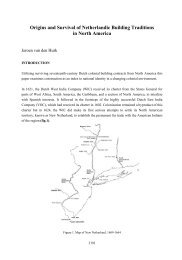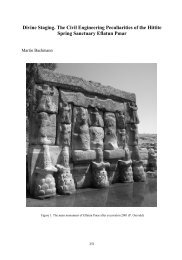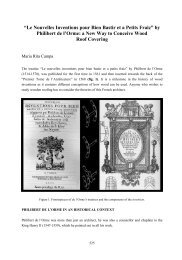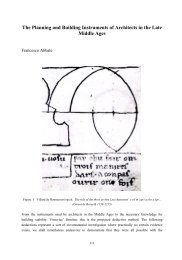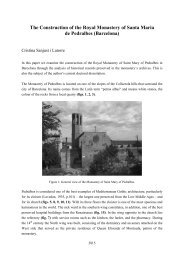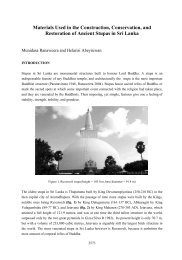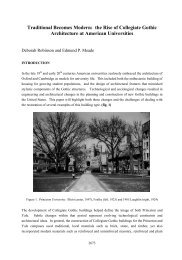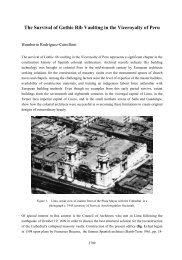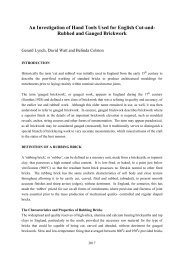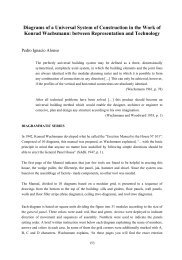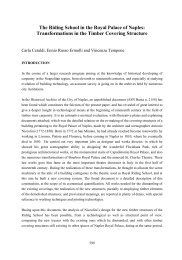bricks from the - Department of Architecture
bricks from the - Department of Architecture
bricks from the - Department of Architecture
You also want an ePaper? Increase the reach of your titles
YUMPU automatically turns print PDFs into web optimized ePapers that Google loves.
22<br />
two inches and an half<br />
7 September 1729:<br />
2 September 1730:<br />
27 October 1735:<br />
26 October 1730:<br />
to a quarter deep or thick':<br />
10~ by 5i by 2~ inches;<br />
10i by 5~ by 2i inches;<br />
10f by 5i by 2f inches;<br />
lot by 5 by 2~ inches.<br />
One agreement specifies that '<strong>the</strong> said moulds to be lined at every<br />
30,000 ... ' and ano<strong>the</strong>r at every 50,000. I understand <strong>from</strong> this that<br />
<strong>the</strong> moulds would increase in size with use and thus needed lining to<br />
produce <strong>bricks</strong> <strong>of</strong> a more uniform size.<br />
The accounts are detailed enough to illustrate <strong>the</strong> cycle <strong>of</strong><br />
brickmaking, beginning with <strong>the</strong> agreements being made in September or<br />
October. The clay was dug in October or November to let frost break<br />
it up, and was turned in January and March. The <strong>bricks</strong> appear to have<br />
been made in April and May with one agreement stating that May Day<br />
was <strong>the</strong> beginning <strong>of</strong> <strong>bricks</strong> to be made in moulds and Midsummer Day for<br />
<strong>bricks</strong> to be burnt in <strong>the</strong> kiln. In o<strong>the</strong>r agreements August seems to be<br />
.<strong>the</strong> kiln month, with one agreement stating that <strong>the</strong> <strong>bricks</strong> had to be<br />
out <strong>of</strong> <strong>the</strong> kiln by 5 September. The importance <strong>of</strong> <strong>the</strong> wea<strong>the</strong>r was not<br />
ignored, for one agreement states tor as soon as <strong>the</strong> season will permit' .<br />
Details <strong>of</strong> <strong>the</strong> kilns are few and as some agreements do not mention<br />
a kiln one may assume that <strong>the</strong>~'-bHicks.were clamp burnt: 7 September<br />
1729: '... and will betwixt midsummer next and so soon aft~r a~ <strong>the</strong><br />
season <strong>of</strong> <strong>the</strong> year permits make burn and deliver to <strong>the</strong> said John Shaw<br />
100,000 <strong>of</strong> hard well burnt saleable <strong>bricks</strong> ... '; 26 September 1730:<br />
'... betwixt midsummer next or as soon after as <strong>the</strong> season permits make<br />
burn and care for <strong>the</strong> kiln ... '; 27 October 1735: '... and set <strong>the</strong>m in<br />
<strong>the</strong> kiln or kilns and dawb <strong>the</strong> same and will light <strong>the</strong> fire or fires<br />
and duly attend <strong>the</strong> well burning through ... '; 26 October 1730: '...<br />
Mat<strong>the</strong>w Motte to make a kiln and floor for £1 Ils 6d ...I; 16 October:<br />
I ••• hard weIl burnt <strong>bricks</strong> to be sold out <strong>of</strong> <strong>the</strong> kiln betwixt next<br />
August or however before 5 September next ... '; 1747: '... George Culburn<br />
also £1 4s Od for making <strong>the</strong> kiln ... '.<br />
The payments for making <strong>the</strong> <strong>bricks</strong> are nearly always given in two<br />
ways. The agreement specifies <strong>the</strong>"'price per 1000 that has been agreed<br />
for <strong>the</strong> good weIl burnt <strong>bricks</strong> <strong>from</strong> <strong>the</strong> kiln. The agreement also<br />
specifies what is to be paid when <strong>the</strong> clay is dugand when <strong>the</strong> clay is<br />
turned, but payments for making <strong>the</strong> <strong>bricks</strong> in moulds, setting <strong>the</strong> kiln,<br />
firing <strong>the</strong> kiln, and delivering <strong>the</strong> <strong>bricks</strong> vary. Numerous little pieces<br />
<strong>of</strong> paper show <strong>the</strong> record <strong>of</strong> actual payments that were made during <strong>the</strong><br />
year that <strong>the</strong> agreement was being executed. It is not possible here<br />
quote <strong>the</strong>m all, but I provide one set to illustrate this point: Agree~<br />
ment 26 September 1730 I ••• to make 200,000 haed weIl burnt saleable<br />
good <strong>bricks</strong> at 4s 8d per 1000 ... John Shaw to pay Richard Gregson £6<br />
for digging £6 for several times turning and <strong>the</strong> rest when <strong>the</strong> <strong>bricks</strong><br />
are weIl burnt and delivered on penalty <strong>of</strong> £20.' (Several agreements<br />
have this penalty clause.)<br />
RECEIPTS<br />
3 October 1730 Received <strong>of</strong> John Shaw £1 lOs Od upon account Richard GregsoJ<br />
30 October 1730<br />
11 £3 3s Od<br />
11<br />
4 November 1730<br />
11 £1 lOs Od<br />
11<br />
21 November 1730<br />
11 £2 2s Od<br />
11<br />
26 December 1730<br />
11 £2 15s Od<br />
11<br />
7 January 1731<br />
11 £2 2s Od<br />
11<br />
9 February 1731<br />
11 £1 Is Od<br />
11<br />
13 February 1731<br />
11 £1 ls Od<br />
11<br />
10 April 1731<br />
11 £1 Is Od<br />
11<br />
3 July 1731<br />
11 lOs Od<br />
11<br />
29 August 1731<br />
11 £2 lOs Od<br />
11<br />
5 June 1731<br />
11 £6 Os Od<br />
11<br />
£25 58 Od



